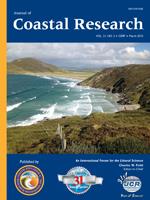Stadler, M.; Salmon, M., and Roberts, C., 2015. Ecological correlates of green turtle (Chelonia mydas) abundance on the nearshore worm reefs of southeastern Florida.
Juvenile green turtles (Chelonia mydas) differ in abundance on nearshore reefs, but why some sites are preferred over others is unknown. Our study had two objectives: to quantify site-specific differences in turtle abundance over time (1 y) and to determine what ecological factors were correlated with those differences. We conducted quarterly surveys on reefs in Palm Beach and Broward Counties, Florida, and compared reef sites with respect to (1) water depth, (2) algal abundance, (3) algal species richness, and (4) fluctuations in reef area caused by sand burial (which kills the algae used as forage by the turtles). Turtles were most abundant on reefs located in shallow water and exposed to bright ambient light. More turtles were also seen at sites where algae were both abundant and composed of many species. Reefs with those characteristics tended to remain uncovered by sand (“stable”) for longer time periods. We hypothesize that foraging by turtles on preferred reefs may prevent any one species of algae from dominating the site, making room for others to colonize. If true, then both physical stability (reef exposure time) and biological activity (turtle grazing) may make some reefs more attractive to turtles than others.





